Appendix B: Signals To Be Used By Officials
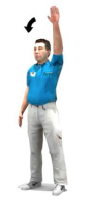
Fig. A
The referee lowers the arm from a vertical position to signal (i) the start of the period (ii) to restart after a goal (iii) the taking of a penalty throw.
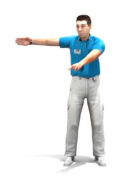
Fig. B
To point with one arm in the direction of the attack and to use the other arm to indicate the place where the ball is to be put into play at a free throw, goal throw or corner throw.

Fig. C
To signal a neutral throw. The referee points to the place where the neutral throw has been awarded, points both thumbs up and calls for the ball.
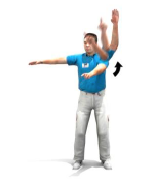
Fig. D
To signal the exclusion of a player. The referee points to the player and then moves the arm quickly towards the boundary of the field of play. The referee then signals the excluded player’s cap number so that it is visible to the field of play and the table.
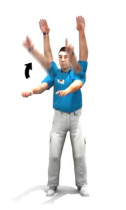
Fig. E
To signal the simultaneous exclusion of two players. The referee points with both hands to the two players, signals their exclusion in accordance with Fig. D, and then immediately signals the players’ cap numbers.
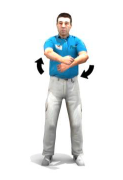
Fig. F
To signal the exclusion of a player for misconduct. The referee signals exclusion in accordance with Fig. D (or Fig. E if appropriate) and then rotates the hands round one another in such a way that is visible to both the field of play and the table in addition to issuing the player with a red card. The referee then signals the excluded player’s cap number to the table.
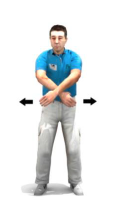
Fig. G
To signal the exclusion of a player with substitution after four (4) minutes. The referee signals exclusion in accordance with Fig D (or Fig. E if appropriate) and then crosses the arms in such a way that is visible to both the field of play and the table in addition to issuing the player with a red card. The referee then signals the excluded player’s cap number to the table.
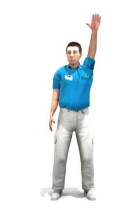
Fig. H
To signal the award of a penalty throw. The referee raises an arm with five fingers in the air. The referee then signals the offending player’s cap number to the table.
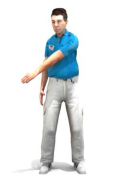
Fig. I
To signal that a goal has been scored. The referee signals by whistle and by immediately pointing to the centre of the field of play.

Fig. J
To indicate the exclusion foul of holding an opponent. The referee makes a motion holding the wrist of one hand with the other hand.
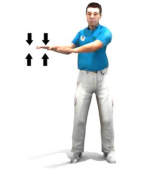
Fig. K
To indicate the exclusion foul of sinking an opponent. The referee makes a downward motion with both hands starting from a horizontal position.
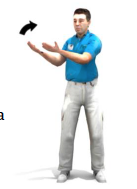
Fig. L
To indicate the exclusion foul of pulling back an opponent. The referee makes a pulling motion with both hands vertically extended and pulling towards his body.
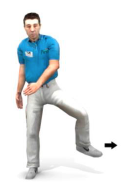
Fig. M
To indicate the exclusion foul of kicking an opponent. The referee makes a kicking movement.
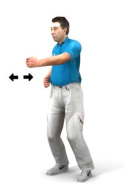
Fig. N
To indicate the exclusion foul of striking an opponent. The referee makes a striking motion with a closed fist starting from a horizontal position.
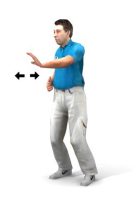
Fig. O
To indicate the ordinary foul of pushing or pushing off from an opponent. The referee makes a pushing motion away from the body starting from a horizontal position.

Fig. P
To indicate the exclusion foul of impeding an opponent. The referee makes a crossing motion with one hand horizontally crossing the other.
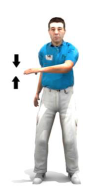
Fig. Q
To indicate the ordinary foul of taking the ball under the water. The referee makes a downward motion with a hand starting from a horizontal position.
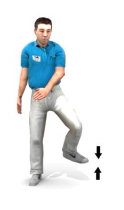
Fig. R
To indicate the ordinary foul of standing on the bottom of the pool. The referee raises and lowers one foot.
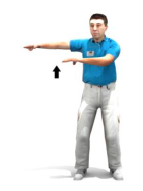
Fig. S
To indicate the ordinary foul of undue delay in the taking of a free throw, goal throw or corner throw. The referee raises a hand once or twice with the palm turned upwards.
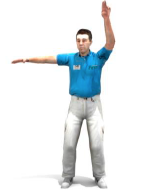
Fig. T
To indicate the ordinary foul of a violation of the two-metre rule. The referee indicates the number 2 by raising the fore and middle fingers in the air with the arm vertically extended.
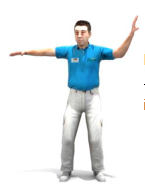
Fig. U
To indicate the ordinary foul of expiry of possession time. The referee moves a hand in a circular motion two or three times.

Fig. V To indicate that a direct shot from outside the 6 m. area is permitted.

Fig. W
By a goal judge to signal for the start of a period

Fig. X
By a goal judge to signal an improper start, restart or improper re-entry of an excluded player or substitute.
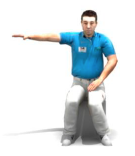
Fig.Y
By a goal judge to signal a goal throw or corner throw.

Fig. Z
By a goal judge to signal a goal.

Fig. AA
To indicate a player’s cap number. To enable the referee to communicate better with the players and the secretary, signals are made using both hands if appropriate where the number exceeds five. One hand shows five fingers with the other hand showing additional fingers to make up the sum of the player’s number. For the number ten, a clenched fist is shown. If the number exceeds ten, one hand is shown as a clenched fist with the other hand showing additional fingers to make up the sum of the player’s number.

















